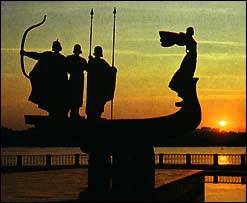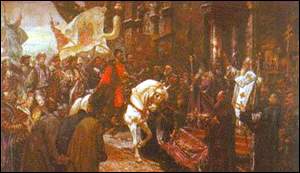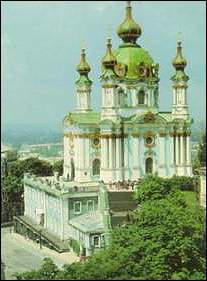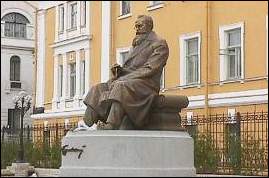
Archeological excavations show evidence of the first
settlements on the territory of Kiev 15,000 to 20,000 years ago. Legend
has it that at the end of the 5th and the beginning of the 6th
centuries, three brothers, Kiy, Shchek, and Khoriv, and their sister,
Lybid, founded a town and named it after their elder brother Kiy, as
"Kyiv". The evolution of Kiev into a city is indivisible from the
development of the old Kievan- Rus feudal state. Legends and historical
documents describe courageous Kievites defending their city over the
ages against the Khazars and Pechenegs, Polovtsi, Tartars, and Mongols,
Lithuanian and Polish feudal lords, the Duchy of Muscovy, and the
Russian Empire.
The early settlers of Kiev built their first citadel on the steep right
bank of the Dnipro River to protect themselves from marauding normadic tribes. Later,
Kiev’s Grand Princes built their palaces and churches on Starokievska Hill, while
artisans and merchants built their houses next to the wharf on the Dnipro. By the end of
the 9th century, when the Kievan-Rus princes united scattered Slavic tribes, Kiev was the
political center of the Eastern Slavs. Kiev maintained wide for links due to its position
in the middle of trade routes between the Vikings and the Greeks. Kiev's development
accelerated during the reign of Prince Volodymir the Great (980 - 1015). In 988, intent on
strengthening his power on the broader international arena, Volodymir introduced
Christianity as the establishment of political and cultural relations with the Byzantine
Empire, the Bulgarians, and other countries of Western Europe and the Near East. By the
11th century, Kiev was one of the largest centers of civilization in the Christian World.
It boasted over 400 churches, eight markets and nearly 50,000 inhabitants. In comparison,
Novgorod, Rus' second largest city, had a population of 30,000. London, Hamburg and Gdansk
each had around 20,000.
After the death of the great Kievan Prince Vladimir Monomakh (1125),
Kievan Rus became involved in a long period of feudal wars. Foreign powers were quick to
take advantage of this situation. In the autumn of 1240, the Tartar-Mongols headed by
Batu-Khan, the grandson of Genghis Khan, captured Kiev after a series of long and bloody
battles. Thousands of people were killed and much of the city was razed. Kiev fell into a
prolonged period of decline. The Tartar- Mongols ruled for almost a century. Despite
foreign rule, Kiev retained its artisan, trade, and cultural traditions of ancient
Kievan-Rus and remained an important political, trade and cultural center.
In the 14th century, the Kiev region became the cradle for the birth of
the modern Ukrainian nation.
In the 15th century, Kiev was granted the "Magdenburg Rights",
which permitted greater independence of the city in matters of international commerce. In
1569, Poland and Lithuania united into what was known as the Rzecz Pospolita Commonwealth.
This led to the establishment of the rule of the Polish and Lithuanian nobility in
Ukraine. Repression by the foreign nobility eventually inspired resistance from the
Ukrainian people.

By the 18th century, Kiev, with its hundreds of churches, the
world-known Pechersk Lavra Monastery, Saint Sophia's Cathedral, a number of other
monasteries and convent became the Russian Empire's center of worship and symbol of
Orthodox Christianity. After the social reforms of 1861 which did away with some of the
worst aspects of serfdom in Russia and Ukraine, some improvements occurred in Kiev's
cultural and economic communities. The number of hospitals and educational establishments
increased.
After the construction of the Odessa-Kursk railroad in the 1860's and
the development of shipping on the Dnipro River, Kiev became a major transportation and
trade center. Transactions at Kiev's grain and sugar exchanges influenced world prices for
food products. The first electric street-car line in the Russian Empire was built in Kiev
in 1892. Home and foreign business communities readily invested Kiev's industries.
Military and political power in Kiev changed numerous times in the years
following the Bolshevik's overthrow of Russia's Czars during the October Revolution in
1917. Between 1917 and 1921, three successive governments of an independent but constantly
besieged Ukrainian State were based in Kiev. On January 22,1918, the Ukrainian Central
Rada (Council), led by historian Mikhaylo Hrushevsky, formally proclaimed Ukraine's
independence. One of the first countries to officially recognize Ukraine's independence
was Russia, who was trying to solidify its grasp over what was soon to become the U.S.S.R.
Shortly thereafter, Russia's Red Army attacked Ukraine. In 1919, amid great fanfare, the
Ukrainian People's Republic, led by journalist Simon Petliura, formally united with the
West Ukrainian People's Republic (which was part of the Austro-Hungarian Empire) based in
Lviv. This union of Ukraine's lands proved to be short lived as the West Ukrainian
National Government's Army lost the war against Polish expansionists, while the Kiev-
based Ukrainian Army was forced out of Ukraine by the Red Army. Soon after, Ukraine was
officially incorporated into the Soviet Union.

The art and architecture of Kiev are world treasures. The Cathedral of
St.Sophia, where the princes of Kiev were crowned in the years of Kiev's grandeur, has
outstanding mosaics and frescoes dating back to the 11th century. Overlooking the old
section of Kiev, Podol, stands the Ukrainian Baroque church of St. Andrew, much beloved by
Ukrainians. The Percherska Lavra the Monastery ot the Caves has two 11th century
cathedrals on its grounds, in addition to its world famous catacombs, bell tower, and
museum collections.Close to the center of town stands the The church of St.Andrew
structure, which dates to 1037. This recently reconstructed remains of the former
fortified wall of the city defined the limits of the city in centuries past. Several
blocks away, stands the magnificent 19th-century Cathedral of St. Volodymyr.
Theater buffs will find much to choose from here. Most performances are
in Ukrainian or Russian.
The recently renovated Kiev Opera House presents very good opera as well
as a broad repertoire of ballets. The Kiev Young Theater is very popular and stages
innovative plays in Ukrainian or Russian. The Ivan Franko Theater is the center of
Ukrainian drama, comedy, and musicals. This repertoire has just opened its 75th season and
includes brilliant versions of Aeneid and Teve Tevel, the original version of Fiddler on
the Roof.
The modern center with surviving parts of the old city are on the hilly
west, or right bank, of the Dnipro River. The main street, Khreshchatik, runs between two
steep hills. Parallel about half a kilometer west, is vulytsya (street) Volodymyrska, the
main street of the Old Kiev area (Staryj Kyiv). From the north end of Khreshchatik,
vulytsya Hrushevskoho rises southeast along a ridge to the Caves Monastery at Perchersk.
Woods and parks cover most of the steep right-bank slopes. The capital's newer sections
stretch out on the flat left bank. These are characterized by large housing developments
and industrialized neighborhoods. Ukrainian pottery, embroidery, and handicrafts are
available throughout the city, particularly in shops and art gallaries (Triptikch, Tadzio,
Mixt etc) on Andrievsky Uzviz, at Percherska Lavra, and St. Sophia's church. Quality and
quantity vary from shop to shop, from gallary to gallary. A growing number of hard
currency stores stock Western food, alcohol, clothing, and electrical appliances.

|